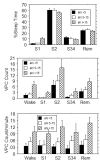Increased ventricular premature contraction frequency during rem sleep in patients with coronary artery disease and obstructive sleep apnea
- PMID: 18982135
- PMCID: PMC2572026
Increased ventricular premature contraction frequency during rem sleep in patients with coronary artery disease and obstructive sleep apnea
Abstract
Background: Patients with obstructive sleep apnea are reported to have a peak of sudden cardiac death at night, in contrast to patients without apnea whose peak is in the morning. We hypothesized that ventricular premature contraction (VPC) frequency would correlate with measures of apnea and sympathetic activity.
Methods: Electrocardiograms from a sleep study of 125 patients with coronary artery disease were evaluated. Patients were categorized by apnea-hypopnea index (AHI) into Moderate (AHI <15) or Severe (AHI>15) apnea groups. Sleep stages studied were Wake, S1, S2, S34, and rapid eye movement (REM). Parameters of a potent autonomically-based risk predictor for sudden cardiac death called heart rate turbulence were calculated.
Results: There were 74 Moderate and 51 Severe obstructive sleep apnea patients. VPC frequency was affected significantly by sleep stage (Wake, S2 and REM, F=5.8, p<.005) and by AHI (F=8.7, p<.005). In Severe apnea patients, VPC frequency was higher in REM than in Wake (p=.011). In contrast, patients with Moderate apnea had fewer VPCs and exhibited no sleep stage dependence (p=.19). Oxygen desaturation duration per apnea episode correlated positively with AHI (r(2)=.71, p<.0001), and was longer in REM than in non-REM (p<.0001). The heart rate turbulence parameter TS correlated negatively with oxygen desaturation duration in REM (r(2)=.06, p=.014).
Conclusions: Higher VPC frequency coupled with higher sympathetic activity caused by longer apnea episodes in REM sleep may be one reason for increased nocturnal death in apneic patients.
Keywords: arrhythmia; autonomic nervous system; coronary disease; sleep; sudden death.
Figures




Similar articles
-
Half of patients with obstructive sleep apnea have a higher NREM AHI than REM AHI.Sleep Med. 2006 Apr;7(3):281-5. doi: 10.1016/j.sleep.2005.10.006. Epub 2006 Mar 24. Sleep Med. 2006. PMID: 16564214
-
Relationship between Sleep Stages and HRV response in Obstructive Sleep Apnea Patients.Annu Int Conf IEEE Eng Med Biol Soc. 2021 Nov;2021:5535-5538. doi: 10.1109/EMBC46164.2021.9630148. Annu Int Conf IEEE Eng Med Biol Soc. 2021. PMID: 34892378
-
[Analysis of sleep structure and related factors in children with severe obstructive sleep apnea-hypopnea syndrome].Lin Chuang Er Bi Yan Hou Tou Jing Wai Ke Za Zhi. 2019 May;33(5):441-446. doi: 10.13201/j.issn.1001-1781.2019.05.014. Lin Chuang Er Bi Yan Hou Tou Jing Wai Ke Za Zhi. 2019. PMID: 31163554 Chinese.
-
Obstructive sleep apnea related to rapid-eye-movement or non-rapid-eye-movement sleep: comparison of demographic, anthropometric, and polysomnographic features.J Bras Pneumol. 2016 Jan-Feb;42(1):48-54. doi: 10.1590/S1806-37562016000000012. J Bras Pneumol. 2016. PMID: 26982041 Free PMC article.
-
Sleep apnea and autonomic dysfunction in patients with dementia.Front Neurosci. 2022 Nov 3;16:951147. doi: 10.3389/fnins.2022.951147. eCollection 2022. Front Neurosci. 2022. PMID: 36408398 Free PMC article. Review.
Cited by
-
Obstructive Sleep Apnea as a Predictor of Abnormal Heart Rate Turbulence.J Clin Med. 2019 Dec 18;9(1):1. doi: 10.3390/jcm9010001. J Clin Med. 2019. PMID: 31861257 Free PMC article.
References
-
- Surawicz B, Knilans TK. Chou's Electrocardiography in Clinical Practice, 5th Edition. Philadelphia: W. B. Saunders Company; 2001. pp. 400–401.
-
- Sajadieh A, Nielsen OW, Rasmussen V, et al. Ventricular arrhythmias and risk of death and acute myocardial infarction in apparently healthy subjects of age>or=55 years. Am J Cardiol. 2006;97:1351–1357. - PubMed
-
- Massing MW, Simpson RJ, Jr, Rautaharju PM, et al. Usefulness of ventricular premature complexes to predict coronary heart disease events and mortality (from the Atherosclerosis Risk in Communities cohort) Am J Cardiol. 2006;98:1609–1612. - PubMed
-
- Abdalla IS, Prineas RJ, Neaton JD, et al. Relation between ventricular premature complexes and sudden cardiac death in apparently healthy men. Am J Cardiol. 1987;60:1036–1042. - PubMed
LinkOut - more resources
Full Text Sources
